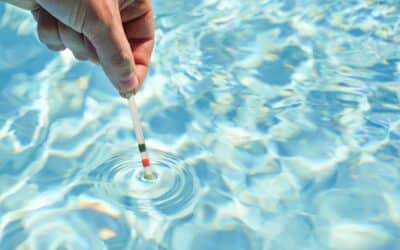Clean the Pool
Clean the walls and the floor of your pool with a scrub brush attached to a telescoping pole, and then vacuum anything that comes loose in this process. It might be worth investing in an algae brush if you don’t already have one, ensuring you can break apart the algae that you’re vacuuming and disturb blooms left in the water.
Balanced Levels
Properly balance the pH levels and the alkaline levels in your pool to avoid corrosion during the upcoming months. Your ideal range for total alkalinity will be between 80 to 120ppm, and your best pH levels will be between 7.4 and 7.6. If you don’t know how to test using a test kit, hire a professional to balance your water for peace of mind.
Service Your Pump, Filter and Heater
Servicing your pool equipment can save you money in the long run since it will keep these key components of your pool system running at the top of their game, expanding their life. If you’re doing it yourself, you want to remove your drain plug, set your main valve to close, attach a shop vac to the pool pump’s drainage port, and use that vac to blow the water out of the pool equipment.
Lower the Water Level
At this point, you want to lower the water below the skimmer level to keep it from overflowing, getting into the pipes and other equipment and freezing over the winter. If you have a fibreglass or vinyl pool, the water should just be below the skimmer. If you have a concrete pool, it should be six to 12 inches below the bottom skimmer level.
Blow Out and Plug Plumbing Lines
This is an important step to keep your skimmer lines from freezing. Set the main valve in front of your skimmer line and use your air compressor or shop vac to the plug opening. When you see bubbles coming out of the return lines, start plugging them. Use a skimmer guard to plug the skimmer line first. Turn off the compressor when you see bubbles coming out of the pool’s main drain.
Winterize Your Pool
The best way to winterize your pool after you’ve achieved the best chlorine levels is to use a non-chlorine shock and then add other chemicals, and finally close the pool. These chemicals are meant to protect it from contaminants over the winter. They include an algaecide to prevent growth spores from accumulating, metal sequestrants to keep metals in your water from oxidizing and staining your pool, and pool enzymes for additional protection from mould caused by leftover pollutants like sunscreen. Add antifreeze specifically built for pools. Don’t shock your water until the night before you put the cover on your pool.
Put On a Pool Cover
You want to install a proper winter cover on your pool, which will include water weights to keep the cover from sinking into the pool over the course of the season. Your winter pool cover should be accompanied by a pool cover pump to remove water from the top. You can also opt for a Pool Safety Cover, which is harder and will prevent people and animals from accidentally falling.
When in doubt, hire professionals to close your inground pool. Benson Pools offers bronze, silver, and gold pool closing packages so you can pay what you’re comfortable paying and feel confident your pool has been closed properly. Explore our options to see what each package includes, and get a quote today!


